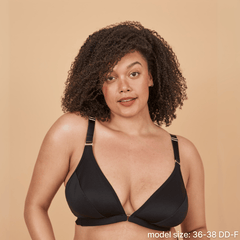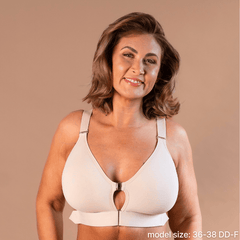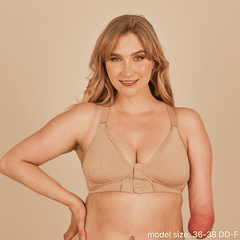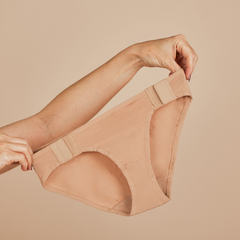
We independently determine all recommended products. If you click on links we provide, we may receive compensation.
Getting dressed is one of those everyday routines that most people barely think about, until something shifts and it becomes a source of friction.
For people living with Parkinson’s disease, that shift can happen gradually, as motor symptoms evolve and once-simple tasks start asking more of the body and mind than they used to.
Buttons become harder to grip. Zippers get stuck. Stretching behind your back to fasten a bra stops being doable. The stakes of a daily routine quietly rise, and suddenly, the clothes you’ve always worn no longer feel like they were made for you.
Why Clothing Choices Matter with Parkinson’s
Parkinson’s is a progressive neurological condition that affects the nervous system and, over time, reduces the brain’s ability to regulate muscle movement. As dopamine levels decline, simple motions can become more effortful or inconsistent.
Tremors, muscle rigidity, and balance issues can all impact the physical process of getting dressed. But it’s not only about movement, cognitive changes and fatigue can also make decision-making and fine motor tasks more taxing than they used to be.
This means that everything from closures to fabric stretch starts to matter more. The right design can make dressing feel intuitive again, while the wrong one turns it into a frustrating daily obstacle.
What to Look for in Adaptive Clothing for Parkinson’s
1. Magnetic or Velcro Fasteners
Hand rigidity is one of the more persistent symptoms of Parkinson’s, making it difficult to manage everyday fasteners that rely on grip strength or fine motor control.
Tasks like buttoning a shirt, pulling up a zipper, or even securing a belt can take far longer and demand more effort.
Shirts, jackets, and even some pants are now designed with Velcro or magnetic fasteners to remove the need for pinching, twisting, or lining up tiny closures.
For example, this adaptive magnetic shirt is designed with both Velcro and magnetic closures, making it easier to slide on from the front and fasten with minimal effort.
2. Front-Closure Bras
For anyone dealing with tremors, stiffness, or decreased shoulder mobility, reaching behind to fasten a traditional bra can feel next to impossible.
Look for front-closure bras with wide, easy-to-grasp closures that don’t rely on delicate hooks or narrow elastic.
The Springrose Adaptive Bras are especially well-suited for people living with Parkinson’s, featuring Velcro and magnetic front closures along with optional grip rings for easier fastening.

Once the front Velcro straps are adjusted and secured through the rings, they can stay in place, allowing the bra to be slipped on overhead like a T-shirt and fastened using the rings at the front.
This setup reduces the need for repeated adjustments and makes daily dressing easier, whether standing, seated, or using one hand.
3. Elastic-Waist Pants with Room to Move
Rigid waistbands and narrow pant legs can become surprisingly difficult to manage, especially when stiffness or freezing episodes make it harder to shift your weight or bend. That’s why elastic waists, soft fabrics, and wide-leg fits are strategic.
Key features to look for:
-
Pull-on designs that don’t require fasteners
-
Stretchy fabrics that allow for easier movement
-
Wider legs and loose hems, which simplify dressing while seated
These adaptive pull-on pants feature a wide waistband, extra stretch, and a relaxed fit, making them easier to slide on and off, whether dressing independently or with assistance.
4. Supportive Shoes and Slippers
Freezing episodes, sudden, temporary moments where the feet feel “stuck” to the ground, can increase the risk of falls. That makes sturdy footwear essential.
Footwear guidelines:
-
Non-slip soles that grip well on tile or wood
-
Lightweight builds, so the shoe doesn’t add resistance
-
Velcro or magnetic closures for easier fastening
-
Avoid slip-ons that can shift or slide while walking

For indoor wear, consider structured slipper boots or house shoes with ankle support and closed heels. They offer a better balance between comfort and security than open-back designs.
These non-slip adjustable shoes are lightweight, easy to fasten with Velcro, and offer sturdy support, ideal for navigating freezing episodes or unsteady footing with more confidence.
New Tools Are Being Designed Every Day
Technology continues to evolve, and with it comes a growing number of tools and innovations built to support people living with Parkinson’s.
From adaptive clothing with hidden magnetic closures to wearable devices that assist with balance or motion, the options are expanding rapidly.
These developments are part of a larger movement to make comfort, dignity, and independence more accessible every day.



